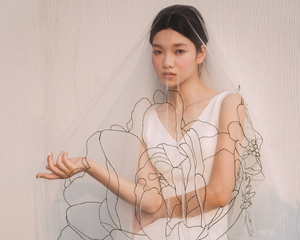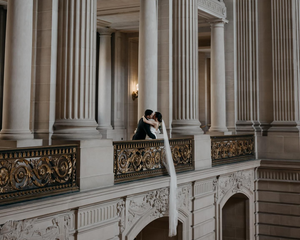You may also like
The wedding veil is one of the most iconic and timeless symbols of a bride’s attire, yet its deeper meaning and origins are often overlooked. Do you know why you wear the wedding veil? Is it merely a beautiful accessory, or does it hold a greater significance rooted in tradition and culture?
In this blog, we’ll explore the history, symbolism, and evolution of the wedding veil. Whether you’re a bride-to-be or simply curious about bridal customs, this journey through time will shed light on what the veil really symbolizes and how this delicate piece of fabric became a central part of the wedding experience.

The Ancient Origins of the Bridal Veil
The use of a veil dates back thousands of years. Early records show that veils were worn by brides in ancient Greece and Rome as a form of protection. In these cultures, the wedding veil was believed to shield the bride from evil spirits that might be drawn to her beauty and happiness on her wedding day. By covering her face, the bride was concealed from these malevolent forces, ensuring a safe transition into marriage.
Similarly, in ancient Jewish and Christian traditions, the bridal veil symbolized humility and reverence before God. It was a sign of modesty, as brides would cover their faces to demonstrate their purity and humbleness. In some cases, it also reflected the belief that the bride’s true beauty should be revealed only to her husband.
These ancient customs reflect a shared desire across cultures to protect the bride and sanctify the marriage union. The tradition of the bridal veil remains one of our most enduring wedding customs, passed down through generations. While many of these beliefs are no longer prevalent, the symbolism of the wedding veil continues to evolve, blending tradition with modern meaning.
The Wedding Veil as a Symbol of Purity and Innocence
One of the most commonly cited meanings behind the wedding veil is its association with purity and innocence. In the Christian tradition, the white bridal veil became popular during the Victorian era, when Queen Victoria herself donned a white gown and lace veil for her wedding to Prince Albert in 1840. This set a trend that has endured to this day, where brides often choose a white wedding veil and dress to signify their purity as they enter into marriage.

The veil’s transparency also plays into this symbolism. Covering the bride’s face until the moment she meets her groom reflects the idea that her inner beauty and essence are being preserved for her partner alone. The act of lifting the veil is thus a metaphor for unveiling the true self, a powerful and intimate gesture that marks the start of their shared life together.
But while purity and modesty have historically been tied to the bridal veil, modern brides often redefine what these symbols mean to them. Today’s brides may choose to wear a veil for a variety of reasons—whether to honor family traditions, embrace the romanticism of the gesture, or simply because they love the way it completes their wedding look.
The Bridal Veil as a Symbol of Transition
Beyond purity, the wedding veil has long represented the transition from one stage of life to another. In many cultures, marriage is seen as a significant rite of passage, and the bridal veil marks the bride’s shift from her life as a single woman to that of a wife.
In some Middle Eastern and Asian cultures, veiling holds a deep cultural significance. For example, in traditional Islamic weddings, the bridal veil, a type of “hijab” or “niqab,” is worn as a symbol of modesty, privacy, and respect. In these contexts, the bridal veil reflects the bride’s transition into a new phase of life, where she embraces her role as a partner and, in some cases, as a matriarch.
In Western weddings, while the overt religious or cultural meanings behind wedding veils have lessened, the bridal veil remains a symbol of the bride’s transformation. The act of walking down the aisle with a wedding veil draped over her face symbolizes the moment she leaves her old life behind and begins a new journey together with her partner.
Modern Meanings: A Personal and Fashionable Choice
In today’s world, the meaning of the wedding veil is largely personal. While its origins are steeped in symbolism, modern brides often see the bridal veil as a statement of personal style rather than a strict adherence to tradition. Many brides choose to wear a wedding veil because they love the dramatic flair it adds to their look. For others, it’s a nod to their family’s long history of following the tradition.

The design and style of the bridal veil have also expanded far beyond the traditional white tulle. Brides now have the freedom to select a wedding veil that aligns with their personality and wedding theme. From lace-trimmed cathedral wedding veils to minimalist fingertip wedding veils, the options are endless. Some brides opt for colorful or embellished veils, adding a unique touch that reflects their individuality.
The Wedding Veil and Its Role in Religious Ceremonies
For many couples, the wedding veil holds religious significance. In Jewish weddings, for example, the veiling ceremony, known as the "badeken," involves the groom placing the wedding veil over the bride’s face before the wedding ceremony. This tradition is said to date back to the biblical story of Jacob and Rachel, symbolizing the groom’s love for his bride beyond her outward appearance.

Bride: Paulina Leal - Zapopan, Mexico. Photo: danielagtzh.com. Veil: Lilly
In Christian ceremonies, the bridal veil can symbolize the bride’s commitment to her faith and her desire to enter into a sacred covenant with both her husband and God. The wedding veil may also signify the presence of God in the marriage, as the couple seeks spiritual protection as they embark on their journey together.
While not all brides who wear a wedding veil do so for religious reasons, for those who do, the bridal veil is a powerful symbol of their devotion and the spiritual bond they are forming through their sacred union. This connection between veil spirituality and marriage ceremonies dates back centuries, reflecting deep cultural and religious traditions that continue to resonate with modern brides.
The Emotional Weight of the Wedding Veil
The decision to wear a wedding veil can be an emotional one. It may represent a connection to the past, whether it’s a family heirloom passed down through generations or a tribute to a beloved family member. The wedding veil can carry memories of mothers, grandmothers, or other important women in the bride’s life who wore one on their own wedding day. Wearing the veil becomes a way of honoring their legacy while creating new memories of her own.

Additionally, the moment when the bridal veil is lifted can be one of the most emotional and anticipated parts of the wedding ceremony. It’s a deeply intimate gesture that symbolizes the bride’s trust, vulnerability, and readiness to step into this new chapter with her partner.
The Evolution of the Veil in Popular Culture
Popular culture has also played a role in shaping how we view the bridal veil. From classic movies to royal weddings, the wedding veil has become an integral part of the bridal aesthetic in the public eye. Who can forget the dramatic moment when Princess Diana’s 25-foot long veil trailed behind her as she made her way to the altar? Or when Meghan Markle’s intricate embroidered wedding veil represented the Commonwealth, with flora from each country delicately stitched into its design?

These moments in pop culture have cemented the bridal veil’s status as a symbol of grandeur, elegance, and romantic tradition. They remind us that, while the meaning of the wedding veil may have shifted over time, its role as a symbol of beauty and significance endures.
To Veil or Not to Veil: The Bride’s Choice
As weddings become more personalized and couples move away from rigid traditions, some brides choose to forgo the veil altogether. For these brides, the decision to not wear a veil can be just as symbolic as choosing to wear one. It may represent a desire to break with tradition, a reflection of their personal style, or a statement of independence.
While the wedding veil is rich with history and symbolism, modern brides are empowered to define its meaning for themselves. Brides will make up their own mind as to whether or not a wedding veil is right for them.
Discover More Wedding Traditions and Trends at TARA Bridal.
Conclusion: What Does the Wedding Veil Symbolize Today?
The wedding veil is a powerful symbol, steeped in tradition yet continually evolving. From its origins as a protective barrier to its role in religious ceremonies, and now as a personal and fashionable choice, the veil carries with it a multitude of meanings. Whether it represents purity, transition, personal style, or holds religious significance, the bridal veil remains a cherished part of the wedding day, with each bride giving it her own unique symbolism.








